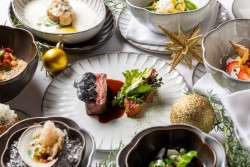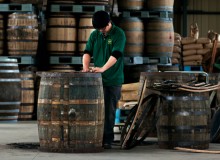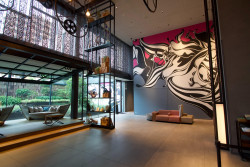
November 11, 2008
Gion Kahala
Vegetables are the star of the show at this new Nishi-Azabu grill
By Metropolis
Originally published on metropolis.co.jp on November 2008
The owners of Gion Kahala come from Kyoto—and they’ve brought their vegetables with them. This posh new eatery aims to recreate the hospitality of the fabled Gion district, specializing in local produce that complements a variety of fish, meat, rice and teppanyaki dishes.
Located just steps from Nishi-Azabu crossing, Gion Kahala fits right in with its self-effacing yet upscale neighborhood. A lack of signage out front indicates the owners’ desire to attract an in-the-know clientele. The interior spreads out over two floors—or two-and-a-half, if you count the private room perched enticingly between the main level and the lower lounge. All the dining areas, from the six-seat teppanyaki grill to the entrance-level counter bar, are designed with comfort and seclusion in mind. Soberly lit and filled with Japanese-themed decor, Gion Kahala, despite its Kyoto pedigree, exudes Tokyo cool.
On the food menu, course dinners range from ¥7,000-¥15,000 and a la carte fare starts at ¥900. Though the chefs use Japanese ingredients and traditional cooking methods, there’s also a definite international feel: Kyoto vegetables are served with bagna cauda, and foie gras terrine is spruced up with a mirin-based sauce. This Western focus is also reflected in the 17-page wine list.
A recent press dinner began with an amuse bouche assortment that included a frothy tonyu soup; a cheese-flavored, mochi-like bread puff; and a wagyu “rillette”—actually a diminutive cube of grilled beef with kuro shichimi spice served on a pastry wedge. This was followed by a sashimi dish of scallops and kinmedai (sea bream), topped with edible flowers and served with a trio of condiments that were drizzled on the plate like expressionist paint swirls. Next up came steamed tofu in a light broth, a dish that struck as ordinary—until one of the cooks arrived tableside to shave some truffle on top.
The addictive bagna cauda that followed, served in a porcelain pot over an open flame, was accompanied by raw radish, cauliflower, green pepper and eggplant. The staff asked whether we would like our next vegetable dish grilled or steamed; we chose the latter and were rewarded with gently cooked pumpkin, potato, spinach and eggplant topped in a thick, sweet miso dressing and dotted with namafu (gluten) cubes. After a black-vinegar granite came the teppanyaki—a predictably fantastic serving of Japanese beef fillet.
Gion Kahala also offers a variety of okonomiyaki and snacks and, thanks to its bar counter and late-night hours, would be an inviting spot to either begin or end an evening.
Ned Says:
The concept of teppanyaki is pretty basic, and for this reason, an uncomplicated and delicious way to eat quality meats and seafood. Given that Gion Kahala prides itself on vegetable dishes, I expected to see a selection of brisk whites and fresh reds. Where are the Alsatians, Germans, Loires and New World examples such as antipodean Rieslings and an array of Pinot Noirs?
Instead, Gion Kahala offers mostly standardized wines from average producers, and off-vintages that tick all of the boxes but speak little of the restaurant’s intent. Michel Noellat is the only decent producer among the Burgundians, while ’89 Vieux Chateau Certan is certainly a top wine among the many listed laggards of Bordeaux—but so it should be at ¥51,000! The best value on the list is ’98 Clos des Papes Chateauneuf du Pape at ¥12,000, although it will annihilate delicate veggie dishes. Stick to the meat with this wine.
But perhaps I am missing the point, as there are more pages dedicated to Champagne than any other wine style, and the choices are broad and moderately priced, such as the imperial Philipponnat Clos des Goisses ’96 at ¥30,000, or the bready Henriot Souverain at a mere ¥10,000. Could it be that the owner is more astute than I am giving credit?
If Champagne is the wine the restaurant would prefer us to drink with its fare, however, why offer all of perfunctory alternatives? My view is create a theme of food and wine pairing that stimulates—and stick to it with passion.
Ned Goodwin is Metropolis’ wine correspondent









